Is Colombia Safe? Some tips for travellers.

Is Colombia safe? Background in security risks in Colombia and tips on staying safe. Updated April 2019.
My original Is Colombia Safe? Blog was written in my Google Travels with Mitzi in 2013, then updated in 2015….
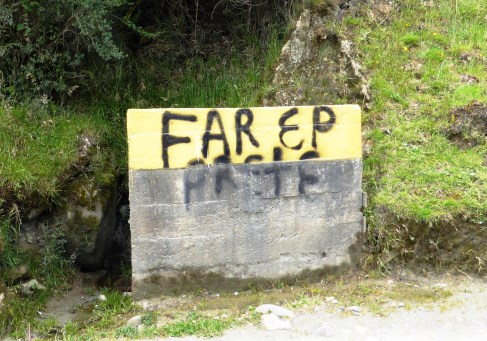
Wow, it’s now 2019 and…things haven’t changed that much since the 2015 update. OK, there was a ‘peace process’ with the FARC that made news headlines around the world, and the FARC are now a political party. But unfortunately the Colombian state had many more conflicts than just with the FARC; the Red Cross announced in 2019 that there are actually 5 armed conflicts current in Colombia…and many more minor scraps over the growing cocaine trade.
People are now realising that the military FARC-EP was actually a good influence on some rural parts of Colombia bringing some kind of peace, law and controls on things like cutting down forest. The peace process and demobilisation has lead to a vacuum now filled with other armed groups now fighting for control, a boom in illegal activities (coca, gold mining, illegal timber) and a new wave of insecurity. Friends and relatives of mine living in rural ‘conflict’ areas report that nothing has changed: communities till face targeted killings, landmines, extortion, threat etc.
What are the trends? Crime statistics are notoriously fickle and events affecting certain categories of the population – like the terrible rise in assassinations of Colombian community leaders – are unlikely to affect foreign visitors the country. Colombia still languishes in the bottom third of ‘world’s most dangerous’ countries ranking and according to murder rates has three cities in the world’s worst 50 cities in terms of homicides, these are Cali, Cúcuta and Palmira (small city close to Cali). In comparison, the U.S. has four cities in the same ‘worst 50’.
As a generalisation the murder and kidnap rate is decreasing in Colombia but the petty crime rate – particularly street attacks – is rising. Drugging crimes such as burundanga (see below) is increasing. Terrorism attacks are also on the rise, such as the ELN car bomb attack on the Bogotá Police academy in January 2019. But, again, these targeted attacks are unlikely to directly affect foreign tourists.
So if Colombia is still dangerous for Colombians, is it also dangerous for tourists? The answer is ´probably not‘. But a lot depends on you: where you plan to go and what you intend to do. Most travellers here will have a wonderful time and do not suffer anything more alarming than sunburn and mosquito bites. And Colombia is still fresh and welcoming to foreigners, and on balance is safer and more accessible to travellers than ever before. The purpose of this post is not to put you off visiting Colombia, just to help you keep safe when you’re here.
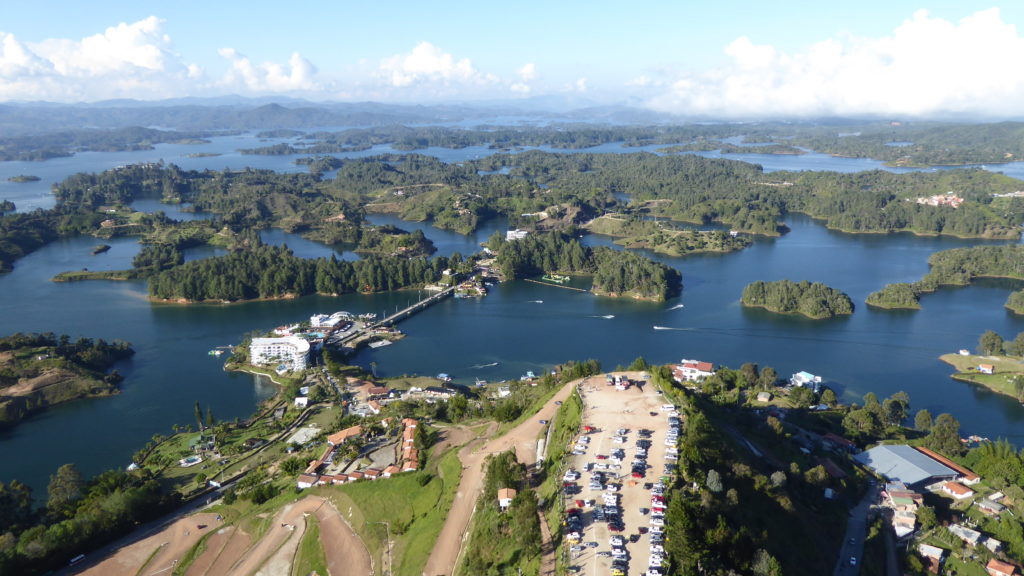
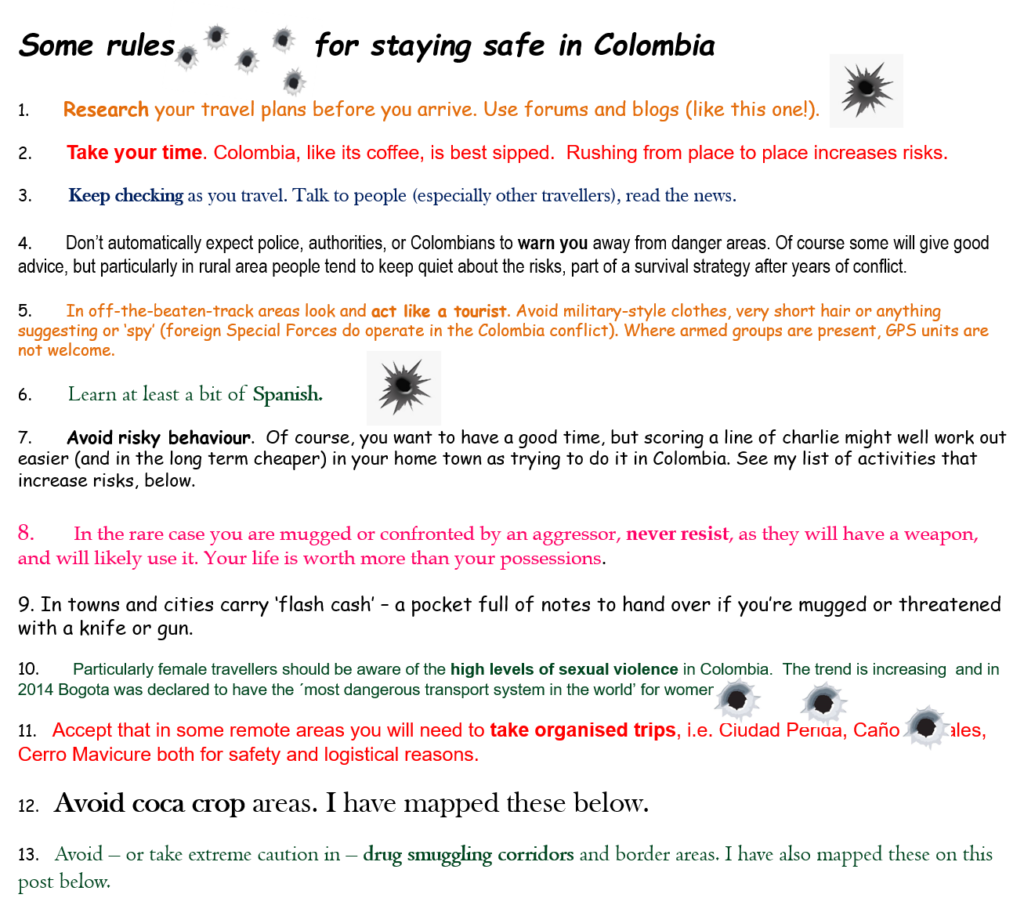
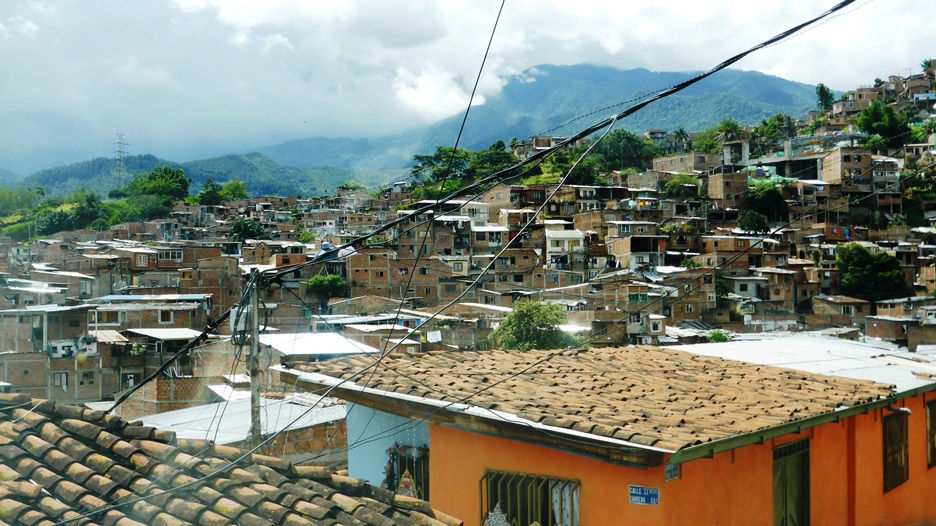
Gangs carry guns openly here.
Why is Colombia considered dangerous?
Here are some factors.
- Coca leaf production (and by inference cocaine manufacture) increased in recent years. Drug production areas and smuggling corridors continue to be highly dangerous to outsiders and sometimes overlap with tourism destinations (ie Gulf of Uraba and Turbo port).
- The ELN, Autodefensa Gaitanistas (also known as Los Urabeños), EPL, and unsavoury variety of drug clans (known as BaCrim after ´Banda Criminales’) thrive and will grow as they absorb FARC fighters in the event of a political deal between the government and FARC in Havana. NEWSFLASH: Bacrim are now known officially as GAO (Grupos Armados Oganizados)
- Social inequality and extreme poverty still exist, and cities such as Bogota registered increases in crime,
- In some touristy areas of Colombia the enchantment with foreign visitors is wearing thin, in fact local gangs are targeting backpackers. This seems to be happening in Taganga, according to recent posts.
- There is a continued rise of local drug trafficking (previously discouraged by large ‘exporting’ cartels) with related rise in ´micro´ gangs, addicts, and petty crime.
- Large areas of the country continue to be under social control by violent, often shadowy, armed groups who threaten citizens striving for social change, just this week teachers in poor areas of Medellin were chased out by death threats from gangs.
- Colombia remains one of the countries affected by landmines in the world, with little effective demining activity. Most mines are around conflict areas.
‘The only risk is wanting to stay´

I worked all over South America as a tour guide, and Colombia was always was the punters´ favourite place. Why? Colombianos. People are genuinely friendly here. So Colombia´s old tourism slogan has much truth in it: many people visiting Colombia fall in love with the country. Some stay.
One of the conundrums of Colombia is that under the surface of this geographically-blessed country lies the dark shadow of crime and conflict. Colombians themselves joke about ´God created paradise – and to compensate added Colombians´. Neighbouring countries used to refer to it as Locombia ‘that crazy loco country’.
Most commentators talk about the ‘two Colombias’: one sophisticated western and urban, the other traditional and rural. I would add a ´third Colombia’, the vast tracts where the state has had minimal presence outside key towns. All have their risks and attractions.
Get with the context…
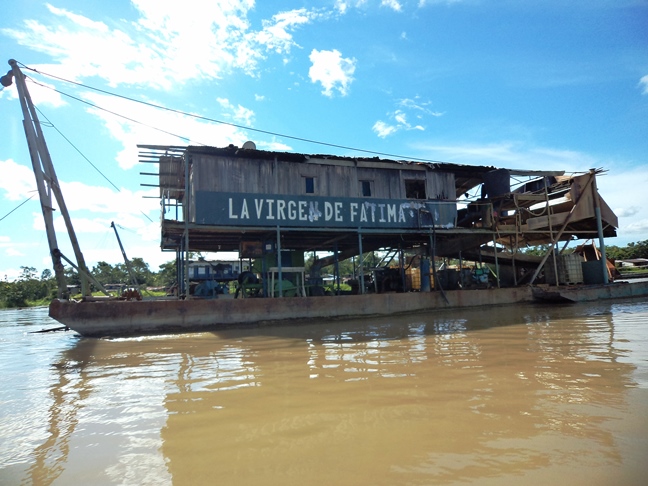
Given the country’s continuing social and conflict problems, travellers visiting Colombia for more than a week are strongly advised to get with the context. This will enrich your visit, open your eyes, but also help you stay safe. On this post are many links to external sites, but also posts on Colombia Corners which can add background, many which I wrote as a contributor to The Bogotá Post and The City Paper, two English-language newspapers here. These posts can be found on Colombia Corners at:
– Colombia Context
– Colombia Conflict
Another good source of recent Colombia news in English is Colombia Reports and has some good background info. This excellent perspective of armed groups in northern Antioquia in 2019 by Mariana Calvo is a great example.
For more history see Fernan Gonzalez’s detailed Historical Perspective of Colombian Conflict (in English). Journalist Joel Gillin gives his overview on conflict causes on Colombia Reports on political causes, and inequality.
The excellent Insight Crime website also has a good overview of Colombia conflict and armed groups.
The Trip Advisor Colombia Travel Forum, although not orientated specifically towards security, has a lot of good info on where’s hot and where’s not.
Of course you might have watched Narcos and Loving Pablo, and the zillions of drug-bust crime series and movies. These are entertaining and give some insight to Colombia’s cocaine wars. Many Colombians are fed up with the projection of their country as lawless, and the worldwide obsession with its drug cartels. They can be quite sensitive to criticism on this topic from outsiders, particularly since many blame (with some justification) the ´developed’ world’s hunger for illegal drugs that fuels the conflict. But they can also put some blame their own TV networks that produces endless telenovelas revelling in violence. As Bogota’s mayor said recently ´To move forward Colombia needs to glorify its teachers more than its capos’.
Who are you? What are you doing?
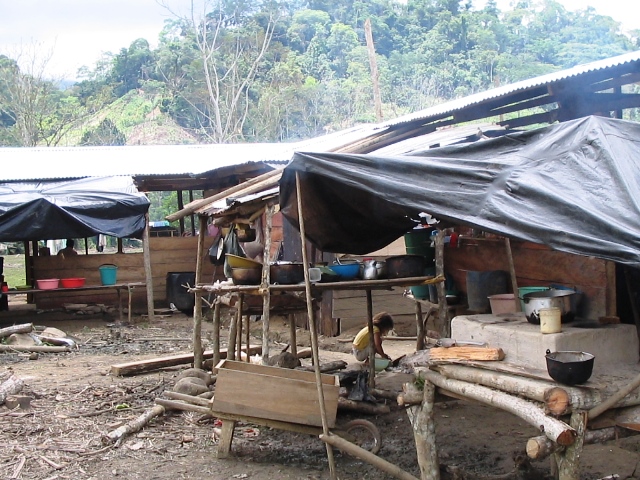
Like anywhere, in Colombia your safety largely depends on who you are and what your plans. Because of its reputation Colombia tends to attract people attracted to risk, so maybe you are a ‘bit of an A type’. If you want danger and adventure you can find it guaranteed in Colombia. The following situations will put you in more peril:
- Sex tourism, particularly with under age sex workers which is unfortunately prevalent in Colombia. Sleazy deals are very common here even outside of tourist areas, but cities like Cartagena have grabbed world headline. As as well as being immoral, its dangerous, and no-ones going to cry for you if you end up in jail. So if you’re coming here for a bachelor party keep it legal, keep your moral compass, and denounce any illegal activity. Abuse of children can be denounced via a special hotline ‘Linea 141′.
- Going on a drugs bender. Ok, you’ve just read The Fruit Palace – one of the best travel books ever written – and want to do your own Fear and Loathing tour of South America. But its going to take you into the orbit of some dodgy people. Just saying.
- You`re self-driving. Actually I drive everywhere here, and many are posts are Road Trips. I encourage hiring a car to see some of the best corners of Colombia. But road accidents stats are massive here. More people die on car crashes than by conflict or violence. So driving is a risk that needs managing. Mountain roads require confident, experienced and defensive drivers. Check my posts with driving tips and how to survive Colombian roads.
- You like going out drinking on your own. Later in this post I’ll talk about burundanga, a drug used to incapacitate, rob or rape victims, often tourists (but also many Colombians too) drinking in a bar or disco. Some victims are overdosed and die. Your risk of being targeted – and being in trouble if you are drugged – are much much higher if you go out alone. So go out in groups, stay in groups, and get home safe in a group.
- You met a Colombian/a on the internet. And you just met their family in Cali and they want you to carry a hollow-sounding statue of Jesus home. Good luck with that.
- You’re a bird watcher or orchid collector who’ll go to any length to find your quarry. Make sure you have a good local guide who knows the area.
- You’re super fit with short hair and like to wear combat trousers while hiking alone in remote areas. But you might be mistaken for a spy or special forces and risk being targeted by drug gangs.
- You bring your I-phone X, Canon EOS5D, and Rolex Daytona to Colombia. Leave super valuables at home.
- You buy a US$3,000 carbon fibre-frame bike to ride around Bogotá. This is more than the average Jose earns in a year. Cyclists of high-end bikes have been murdered for their rides. Buy a cheap or old bike. See my post on Bogotá’s Super Ciclovia for more info.
- You’re a journalist, aid worker, human rights activist or trade union organiser . These are all noble vocations but exercising them in Colombia will increase your danger. Colombia has many threats to media workers – and some killed every year – and has more trade unionists killed annually than the rest of the world combined.
- You set up a business in Colombia: which of course many people do: but it comes with risks, many related to human resources. As the senior manager of an international NGO in Colombia for many years I investigated maybe maybe a dozen serious-sounding threats against the organisation and staff: all turned out to be internal threats from employees with a grudge, covering up for corruption and theft, or ‘lios de faldas‘ (literally ‘skirt mess’ or love triangle kind of situation).
- You become a target for extortion: related to above, if you have a high profile or run a business here, you increase the risk of being targeted for extortion. Most areas of Colombia (perhaps with the exception of Bogotá) are dominated by GAOs (see above) who extort money with death threats with an estimated US$1000 million paid to gangs each year. Since these gangs are often linked to local politicians and law enforcement, they are hard to root out: many people just pay. Foreigners are also caught up in this, as in recent years with the violent Los Pachencas gang in the Sierra Nevada de Santa Marta.
So what are the main risks?
Quick crimes: Petty crime, street robbery, mugging, theft, pickpocket. These apply to many countries in the world, but there are some risks particular to Colombia, and especially in areas where a lot of tourists are present like Cartagena. These are carried out by organised gangs (particularly in downtown areas) who rule the streets, or by very desperate drug addicts looking for a quick fix, and occur every day to hundreds of Colombians too. Common sense can avoid most of these, and your correct reaction (give them what they want) keep you alive.
Common in Colombia are:
– bag snatching, phone snatching, mugging: often on buses or at transport hubs, or on the street from bicycles or motorbikes, attackers are armed with guns or knives and will kill or maim you if you resist. Sometimes late at night or in empty street in daytime. Sometimes walking in rural areas. It will happen in a flash.Sometimes even young kids attack. Never resist unless you have some serious firepower. Better to have flash cash.
– distraction attacks: similar to above but with some distraction to get you off guard, pretty woman asks for direction while guy blind-sides you and takes rucksack.
– sneak bag theft in restaurants. Gangs with well-dressed thieves work up-market bars and restaurants, and staff are often in on it too. They can magic your bag away from under your feet, and your phone and wallet from the table. Keep a good watch.
Elaborate crimes: These are mostly scams and drugging, and the infamous paseo milionario, in which taxis kidnap you, threaten to kill you until you hand over your cards and pin number. Which is a good idea to do. I mentioned burundanga above, and it is a real risk in Colombia. These crimes carry the added risk of sexual assault, especially for females, and some burundanga victims are raped and robbed, or killed as in the case of a Turkish professor. I have been drugged (in Peru) and wrote and researched on it for the Daily Telegraph some years back. Scams can take many forms, such as fake cops asking to check your cash for ‘fake notes’ to a motorbike that hits you (at low speed) then crashes and a cop jumps out and demands money to repair the broken bike (never mind your damaged leg). To be honest these scams are rare, if you feel you are being tricked then walk away and seek a crowded area.
There is now an Uber scam at the airport, since Uber is tolerated but technically illegal in Coombia, the police wait for tourists to get an Uber then shake them down for a ‘fine’. Avoid using Ubers at the the airport. Some taxi scams are quite tricksy such as the nice old driver whose old taxi stalls at the traffic lights. ‘Maybe give me a push’, he asks his tourist passengers. They jump out to push the taxi. He starts the engine and drives off into the night with all their bags in his boot.
Another taxi scam recently reported was a driver using a fake ‘card machine’ for ‘credit card payments’ which was in fact a card scanning machine. The card were declined then the driver used the card details. Best use cash in taxis.
Organised crime/conflict risks: let’s be clear, Colombia is infested with drug gangs, illegal armies, deadly cartels, and corrupt politicians and ineffective (and sometimes criminal) police and armed forces. The fault for that lies equally with drug consumers and corrupt banks – yes, your high street bank! – in wealthy first world countries whose blood money (US$12 billion a year in cash, by conservative estimates) flows back to Colombia. If you don’t believe me read ZeroZeroZero by ace investigative journalist Roberto Saviani.
Also see my context post here ‘It’s the Narco Economy, Stupid‘ and ‘The Writings on the Wall’
But Colombian drug gangs and illegal armed groups are usually highly organised, run with strict internal rules, and (generally) abide by the motto ‘don’t make waves’. Sure, they will kill countless criminal competitors in turf wars over cocaine production, smuggling corridors and the myriad spin-off illegal activities they control (extortion rackets, prostitution, illegal mining, gambling etc) but they do not have any interest in harming travellers visiting Colombia. In fact in stable areas dominated by one armed group there is often a perception of ‘the streets being safer’ as armed gangs carry out ‘social cleansing’ and remove petty criminals (usually by threatening or murdering them).
Wrong place, wrong time

So we agree that drug gangs making millions of dollars from cocaine generally have no interest in drawing attention to themselves by harming tourists to Colombia. But they do defend – with extreme violence – their territories and threaten anyone entering zones where illegal activities (can be urban or rural) take place. Some of these high-risk zones overlap with tourist routes, and this is where travellers need to be cautious. Don’t get caught in the wrong place at the wrong time.
This happened to Swedish backpacker Jan Philip Braunisch, who disappeared in the border area with Panama in 2013, and turned up dead in 2015. He was travelling on the Atrato River, in the Chocó (not a very touristy area) when the boat was stopped by an armed group. Jan Philip was abducted and shot, possibly suspected of being a spy. The area he was killed is a notorious drug route through the Darien Gap, and in my blog Lost in the Darien Gap I analyse more in depth the events leading to his sad fate. Also see my follow-up after two years of investigation Killed in the Darien Gap. For safer routes along the coast from Colombia to Panama see my post Colombia to Panama on the Darien Coast.
The risk mosaic
Colombians tend to be more aware of ´go´ and ´no go´ areas but also get caught out, as in the case of two Bogota students killed by a drug gang while filming wildlife in rural Cordoba. The gang was shifting a large consignment of cocaine through the area and did not want to leave witnesses. Admittedly none of the cases above are from commonly touristed areas, and in all cases these were independent travellers who didn’t use guides or local tour agencies and (it seems) were used to taking risks. But many travellers like to push boundaries and take the road less taken, so we can expect the same adventurous spirit in Colombia. Actually in 2014 I slipped up myself while trying to drive into a mountainous area east of Cali where the FARC 6th front were in combat with the army. Five years later in 2019 the area still has security problems
The examples covered in the posts linked to above on Colombia’s frontier with Panama show that ‘dangerous’ and ‘safe’ zones of the country exist side by side in a mosaic. This applies to city blocks as much as large swathes of rural Colombia. Of course there are no handy signs up saying ‘Tourist, You are Now Entering an Unsafe Area’. And areas are changing over time, some times quickly. So how do you navigate this mosaic?.
In cities and urban areas: up-market areas are often interspersed with poor barrios, where muggings are more likely. Check with hotel/hostel on local safety, danger times (usually late at night but can be early mornings when streets are quiet), any no-go areas, but also use your senses. If you feel you ‘took the wrong turn’ and feel uncomfortable turn back quickly the way you came. Public transport systems and taxi will carry you quickly between ‘safer’ and ‘more dangerous’ areas, so be alert, don’t take out phones or valuables on buses, and lock door in taxi. Note that main transport routes through cities – such as the Transmilenio in Bogotá – act as crime channels and these routes and nearby streets are often more insecure even in ‘safer areas’ of the city. One example is Avenida Caracas in Bogotá, which is generally unsafe at night.
An example of a ‘linear mosaic’ of safe/unsafe is visiting the TransMiCable in Bogotá, see my post Riding Bogotá’s TransMiCable. The cable car crosses the poorest barrios in Bogotá but is very safe as a new well-guarded system. But the Transmilenio bus to reach the cable car station is insecure, as it runs through some dodgy barrios in the south of Bogotá where the Transmi stations are usually unguarded with all the doors broken, giving criminals easy access and escape route.

In rural areas: the impact of truces between gangs on violence on underlines the fact that in some area of Colombia criminal gangs control the security environment rather than the state security forces. This adds to the headache of navigating the risk mosaic. In the blog below I give more details on areas of Colombia where I consider safe, less safe, and downright dangerous. Below I have given some more detailed info and sources on safer/less safe area, and a map showing in 2019 the ‘gringo route’ -popular and generally safe areas – ‘go with caution’ areas and ‘do not go’ areas. Remember this is just my take on the situation and the situation is changing rapidly.
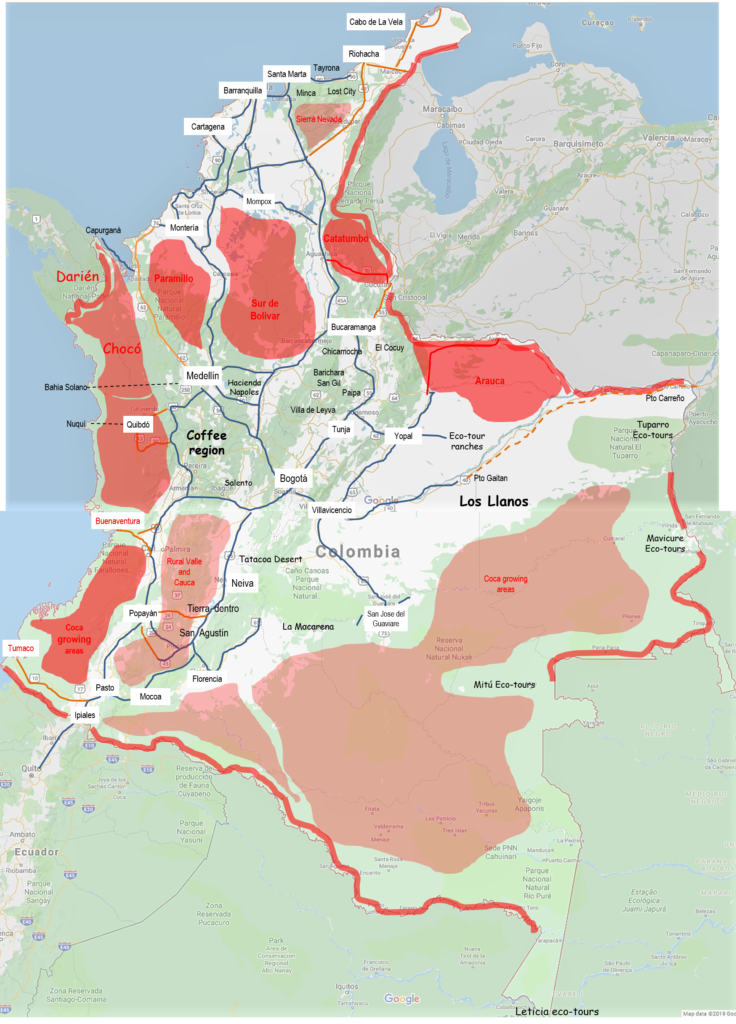
My map of safer ‘gringo’ routes in blue main travellers destinations and rural areas that need caution (in red). Orange routes are to be taken with caution – check first. All land border areas, apart from the main road crossing areas, are dangerous. Bahia Solana and Nuqui are fly-in and safe. Quibdó is safe, but any river travel deeper into the Chocó is to be done with great caution. Medellin-Turbo then by fast boat to Capurgana (and on by coast) is safe, but don’t hang around in Turbo and proceed with caution. Buenaventura and Tumaco can be reached by land but with caution. Touristy areas of the Sierra Nevada (Tayrona, Palomino, The Lost City, Minca) are safe. Quibdó is safe, but other areas are potentially dangerous. Cabo de La Vela (La Guijara) is OK on a guided tour. Any travel close to the Venezuela border is dangerous. I have more details in the text below.
Where to get updated information?
Of course, Colombians are usually the best source of data on their own country, but as mentioned above do not always take this for granted. This is partly for cultural or language reasons. There is a polite tendency in rural areas to answer a polite ‘yes’. If you ask ´can I travel to Tibu?´ the answer could be yes, even though it should be ´no´. Colombian conversation is peppered with charming euphemisms that if not fully understood could mislead you in your quest for information. Lack of clarity on safety can extend to officials and police etc., perhaps simply because they are not so used to travellers in some areas. A good recent example of this is in the Youtube video of backpackers trying the cross the Darien Gap from Panama. The Panamanian police steadfastly refuse the allow them to cross inland. So they travel by the Pacific coast. But once in Colombia, as the commentator says ‘there is a strong military presence…but they just don´t seem to care where we want to go´.
Although most travellers see the official ´travel advisories´ issued by their own governments as overcautious, in some cases they make a good starting point. The UK Foreign Office Colombia travel advice issues a blanket warning against Colombian departments bordering neighbouring countries. Australia advice to citizens is more detailed but excludes relatively safe areas such as southern parts of rural Antioquia, and Huila.Canadians get similar recommendations. The US government travel advice is less specific, though states how and where US embassy staff can travel (which is fine if you can afford to fly everywhere!).
Other travellers is a good source of information, either those met on the way or via online travel forums including Lonelyplanet Thorn Tree, Fodors, …there are more out there. Currently the TripAdvisorColombia forum seems the most active.
Looking at websites of Colombian tour companies can give a hint to independent travellers to see where organised trips are going, try Colombian Way, Palenque Tours, See Colombia, Colombia 57, Voyage Colombia, Uncover Colombia , Colombia Eco Travel and the official tourism site Colombia Travel.
For daily news in Spanish try ElTiempo, La Semana and La W Radio. A useful source for major Colombia news in English (and analysis) is Colombia Reports, less up to date (but with good analysis) are the Bogota Post and City Paper.
If you plan to visit remote rural areas, then you can look at potential conflict zones with the help of Insight Crime carries which published details of armed groups, the UN’s Office for Coordination of Humanitarian Affairs website has up-to-date maps, click on maps/infographics and search for various examples. These resources are not designed for tourists, rather to guide humanitarian response. But the fact that crisis areas often equal conflict areas gives a good clue to where not to go.
EXAMPLE OF UPDATED SECURITY INFO
As writing this post (April 2019), Colombia Reports reported that FARC dissidents had banned tourism in the San Jose del Guaviare region. this is an increasingly popular tourist spot (see my post: Taking the Plunge in Guaviare.) How real is the threat? The local mayor was fast to deny the rumours. Hard to know who to believe, but anyone travelling there would be wise to check carefully along the way….
NATIONAL PARKS
Colombia’s National Parks can cover safe, less safe and dangerous areas. Some are home to armed groups and coca plantations (ie Los Katios and Paramillo) . Some parks are so massive they cover various departments, geographical zones, and can be safe and dangerous, depending where you go. The parks website declares some parks closed to the public, and it is not clear why (can be for security or environmental reasons, or in some cases legal cases between the national parks and indigenous communities). To confuse things more, some parks are officially ‘closed’ while in reality visitors regularly go there, (such as the Estoraques in Norte de Santander, and Sumapaz south of Bogota). Some parks (ie La Macarena) are safe for organised trips (to the amazing Caño Cristales) but not recommended for independent travel. Some are declared ‘open with restrictions’, in which case the Parks website give details of open and restricted zones.
RECENT COLOMBIAN TROUBLE SPOTS
Using some of the tools described above I have mapped recent (August 2015) conflict trouble spots. This OCHA map shows areas of mass displacement of civilian families from conflict/violence during 2015. Reviewing this in 2019, nothing has changed much..
The flashpoint in Norte de Santander refer to the ‘Catatumbo’ border area with Venezuela, which also covers the Parque Nacional Natural Catatumbo Barí (Norte de Santander). This is a stronghold for guerrilla groups (who have presence on both sides of the border) and is very dangerous, with mines and combat.
The Chocó flashpoint refers conflicto and threats in the Rio Baudo area, south of Quibdo, which has displaced many families. In fact all of the Choco is risky, including the Atrato River system, with the exception of the fly-in Pacific resorts of Nuqui and Bahia Solano, and Caribbean coast resorts around Capurgana (which are accessible from ports on the Gulf of Uraba, such as Turbo, but take care).
Valle de Cauca flashpoint refers to attacks on Pacific coastal communities around Buenaventura, which is also a port city with extreme levels of gang violence (but can be visited with caution for the whale-watching). This violence along the coast extends south to the port city of Tumaco (Nariño).
DRUG CORRIDORS
As I wrote above avoid coca growing areas and drug routes, these are shown below. Note some overlap with the displacement flashpoints above. Again, reviewing this in 2019 the routes are all the same. Cocaine production is increasing.
Key to Drug Routes Map
1. Drug sea and land routes around the Darien and Caribbean Coast
Only in remote areas to these potentially become a danger to tourists. Take care in rural Cordoba, north of Arboletes, around the Rio Sinu, and south along the Antioquian ‘Uraba’ coast to Necocli, Turbo and Apartado. Many travellers cross to Panama from Turbo, by boat to Capurgana and San Blas Islands. This is OK, but stay on the main routes. Avoid any rural or inland areas, and river travel in the Choco. Do not go inland into the Darien Gap, this is highly dangerous, or try and enter Los Katios National Park. See my blog here on safe passages around the Darien Gap (at end of blog). and Colombia to Panama on the Darien coast.
2. Chocó: most of the department, the poorest and most abandoned in Colombia, is largely no-go especially the mountain jungle border with Panama (the Darien Gap) and other Colombia departments (Cauca, Risaralda, Antioquia) are also very dodgy. The few main roads (to Isthmina and Quibdo) are OK, but with caution, and Quibdó is safe. River travel down the Baudó (south of Isthmina, see my Alto Baudó post here) or Atrato (north from Quibdo) is dangerous, with possible check points and abductions by illegal armed groups. Some adventurous travellers do make it through, but at some risk. The fly-in Pacific coast resorts of Bahia Solano and Nuqui are safe (and highly recommended) as is the Darien Caribbean coast resort of Capurgana (see 1 above) and beach hopping to Panama. See my post on Nuquí’s spectacular beaches
3. Valle and Cauca coast around Buenaventura another remote and hard-to-visit area, though the city of Buenaventura (also Colombia´s main Pacific port) is slowly improving and backpackers make it there to go whale-watching and enjoy San Cipriano (on the Cali-BVA road). Any coastal routes north or south of BVA should be avoided. Take also care in BVA itself.
4. Pacific coast bordering Ecuador. Jungles and mangrove swamps provide cover for drugs shipped by sea (sometimes in home-made submarines) and illegal groups, and around Tumaco is hot. See my post on Tumaco here.
5. Small patches of coca cultivation in the hills around the main road heading south of Popayan to Pasto. Safe to transit through (on the main road) and not much reason for travellers to visit rural areas.
6. Putumayo and Ecuador border, plus parts of Caqueta south of Florencia. Tense area where problems have spilled over the Ecuador, with coca cultivation and sporadic violence. Red areas cover the road and river routes south of the town of Mocoa, covering parts of the La Paya National Park, though technically the park is open check carefully in Mocoa before going there. Many travellers do head to Mocoa and Florencia, and there are attractions, but proceed with caution.
8. Coca cultivation and smuggling routes from Eastern Llanos to Venezuela these are remote areas not much visited, and best not to enter. Further south, in Guiania, a large FARC group illegally mine coltan, making the La Reserva Nacional Natural Puinawai a high risk area. Some of Guainia closer to the main town, Inirida, is accessible, ie the Cerros de Mavicure.
9. Arauca department border with Venezuela, strategic point for ELN guerrillas (who often attack oil companies etc). Fast transit through this area is OK, but do not hang around. Mines in rural areas. Arauca has for some years registered the highest levels of conflict incidents of all Colombia, but is not much visited by travellers.
10. Coca growing areas in ´Bajo Cauca River’ area of north Antioquia, south Cordoba, and Sur de Bolivar. Also an illegal gold mining región. Main road travel is OK (i.e. Medellin to Monteria) and large towns safe to stop or overnight. But do not leave the main road. Danger areas cover the Paramillo National Park, river areas of the south of Cordoba (Alto Sinu) and towns like Tierralta, Valencia etc. Do not enter or try and cross the ‘Sur de Bolivar’ región such as Montecristo, Nechi etc.
11. Catatumbo area of Norte de Santander, (anywhere just north of Cúcuta) as noted in the humanitarian flashpoints, above, is a guerrilla stronghold and both smuggling and cocaine production zone. Do not enter.
LANDMINES
Colombia has close to 11,000 mine-related injuries and deaths since 1990, most mines being laid by illegal groups to protect bases and coca cultivation. Not surprisingly then the map below (of incidents per department for a 5-year period to 2010) correlates closely with the coca growing areas mapped above. Some additional mined areas on the maps below are the the central cordillera south of Tolima, a traditional FARC stronghold, and Montes de Maria (in Bolivar and Sucre) which was also strategic for the guerrillas.
Most mine accidents happen when state soldiers approach guerrilla positions, but many civilians have also fallen victim and even children, usually in rural communities in conflict zones. One agreement of the peace process with the FARC is that they take part in demining but so far progress has been slow. Some reports suggest it could take decades and US$100 millions to clear the mines in Colombia’s difficult terrain.
Luckily, to date, there does not seem to be even one mine accident with travellers to Colombia, even though some popular tourist attractions, such as Caño Cristales, are in mined areas like La Macarena. This is one good reason to go with a guided tour. But as more areas open up to tourism the risk will increase for hikers and go-it-alone adventurers.
VISITING RISKY AREAS OF COLOMBIA
These tips might help
- Check the online sources (even small communities have internet cafes these days) with some of the sites I have linked to above. Has there been combat or army operations announced for the area? Landmine accidents? Buses burned? Roadblocks (retens), killings or bombings in recent weeks? Large quantities of drugs found? Spraying for coca plantations? Gang leaders arrested or killed? What does the local graffiti say and whose writing it?
- Check with authorities but also talk to locals. Commercial drivers (buses, boats, taxis and trucks) are good sources of information on the route ahead. Check for rumours of armed strikes ´paro armados¨
- Use your eyes. Are there other travellers heading your way? Is transport flowing freely? Are cars or boats ´holding back´ (pulled over to check the motor!) at a certain point? Does the town suddenly shut down at 8pm (could be an unofficial curfew ´toque de queda‘ called by an armed group or gang). Breaking the curfew can put you in danger.
- Look and behave like a tourist.
- Don´t wear military-style clothing.
- Give someone you know (friend or family) your travel plans and send them a contact message when entering/returning from deep rural areas. This will help them if you do disappear or get in trouble.
Recreational drugs
Many travellers take drugs like ayahuasca, the potent hallucinogenic drug used by shamans and new-age types to get out of their tree. In fact it is a quite common middle-class thing here in Colombia (in fact I was having tea with two neighbours, a middle-aged lawyer and a nun, recently as the recounted their ‘yage’ trips). Traditionally the shamans who take their sacred drug used for divination and healing have years of preparation for the ritual, so the question arises why they are giving it to gap-year backpackers?….the answer is of course money. In 2014 a British backpacker died after a drinking ayahuasca in a ceremony in Mocoa. Many guidebooks advise to ´only take ayahuasca in the presence of a respected shaman´ but in Colombian culture there is recognition of brujos, false shamans who use ayahuasca to ´steal´ the life force from victims duped (then doped) into a false ceremony. How to tell the shamans from the brujos? If you know the answer to that you probably don´t need ayahuasca.
In the cities
Petty crime is everywhere in the big cities, but the overall trend ois that violent crime rates dropping (Bogota is now safer than many US cities). Some tips on avoiding street crime –
- Stick to busy streets, and well-lit areas at night.
- Avoid carrying valuables, but if necessary use tubigrip leg bandage for passport, credit cards etc and reserve money. Never carry essential valuables in your jacket or bag – these are the first things to go.
- Bag-snatching is common on buses, in busy city centres, and street cafes.
- Never resist a robbery, as thieves carry knives and will use them.
- Carry a wallet or purse with reasonable quantity (50,000 pesos) of ´flash cash´ to hand over if robbed.
- Use ATMs inside banks or shopping centres.
- Have loose coins to give beggars and street people.
- If approached on the street by well-dressed people claiming to be ´special police´ and asking to check your documents then politely refuse, seek refuge in nearby shop or cafe.
- Register your arrival with your embassy (online) and keep scans of important docs (ie passport) where you can access them online to speed up any recovery operation.

Taxis and the paseo milionario
Organised gangs (Los Canarios) use taxis to rob people, called the ´million ride´, which often takes the form of an express kidnapping while the gang use your credit and cash cards to get money from ATM, having threatened you to tell them your PIN number. The taxi you are in takes a detour to a back street; two people get in (one each side of you) and they search you for valuables and bank cards, you are then held captive until the money is taken from your account (usually a million pesos, which is the limit of cash your card will deliver). The gangs will kill people who resist, as in the case of a US DEA agent murdered in Bogota in 2013. Avoidance –
- If flying in, you will probably first set foot in Colombia’s Bogotá El Dorado airport. CHANGE MONEY ON ARRIVAL as if you use US$ cash for taxis you will be ripped off. When looking for a taxi IGNORE THE TOUTS in the arrival area, also ignore the white cars – they will charge double – and join the queue for the yellow taxis. The queue moves fast and soon the taxi controller in a yellow bib will assign your car. IGNORE the guys ‘helping you’ loading the taxi (and keep your valuables close). Once in the taxi give your address and make sure he starts the clock. Rides from the airport have surcharge, with other extras late and on Sundays. Still, Bogota has some of the cheapest taxis I know for a capital city. You should pay between $25,000 and $40,000 (US$8 to US$13) to get to your destination depending in traffic, time of day etc.
- At your hotel /hostel ask reception to to always call a taxi rather than stop one on the street. You will be given a two-number code which the taxi driver confirms with his dispatch before the journey.
- On the street I flag taxis during daytime, this is safer if you are two or more people. At night I use a taxi app to get a taxi. With your smartphone, try using the app TAPPSI which can order a registered taxi to your location, and works in Bogota, Medellin, Cartagena and Barranquilla (but will expand). Some more exclusive (and more expensive) taxi companies use membership schemes (which visitors can also join) and pre-paid cards ie TAXIMO. Apps and systems are constantly changing so check with your hotel/hosts for the latest best version.
- Uber is illegal but widely used and many travellers find this the cheapest and easiest way to move around the cities. DO NOT USE UBER TO AIRPORTS as you might be fined/scammed by the police where they prey on foreign travellers. Some taxi gangs attack and beat up Uber drivers, and passengers have also been injured, though this is rare.
Burundanga
The drug burundanga comes from the angel trumpet flower plant(often seen growing innocently in gardens in South America) and is in effect a natural source of scoplomine (the ´pre-med´ anaesthetic you might receive during surgery), originally used in shamanistic practices among jungle people of South America. Today people are drugged with it to render them ´auto-suggestive´ (a kind of zombie-like state) to rob them or sexual assault. Over the years it has hit the headlines in the media at various times, sometime discounted as an urban myth. However, if you talk to local medics working in A&E departments in Colombia you will find it is a very real problem, as much for Colombians are tourists.
One problem is that the drug causes confusion and memory loss, it is often given to victims drinking in bars, so mixed with alcohol the victims are often not aware of the effects, and in mild doses victims might never even realise they have been drugged. People react in different ways, and a strong dose will kill (though this is rare since burundangueros want their victims conscious but compliant, so use minimal doses). I was drugged with burundanga once in Lima, I had memory loss then flashbacks afterwards, it took me several weeks to figure out what happened (when I met other travellers who were drugged and robbed in the same up-market bar in Lima).
I have met several travellers over the years in Peru, Colombia and Ecuador who have been drugged, some in a very bad state (sexually assaulted, robbed of everything). One backpacker ´woke up´ naked in a hospital bed in Cali after losing a week of her life (she last remembered boarding a bus in Bogota for Popayan). It took her some months to get her life back together again. From what I can gather many tourists fall victim in up-market bars, after being approached and befriended often by young well-dressed locals who speak good english. But also I met people drugged on local buses by friendly local families offering to share food!
How to avoid it? Single people or those travelling alone are much more likely to fall victim. The Bogota City Paper has a good overview of the drug and prevention, repeated below –
1. Avoid going to or spending time in bars and nightclubs alone.
2. Never accept drinks or smokes from unknown people.
3. Keep an eye on your drink.
4. When going out at night, leave credit cards, ATM cards, expensive watches and jewelry at home. That especially goes for your passport (although keeping a photocopy handy is a good idea).
5. Be suspicious of strangers who approach you on the street, and keep a distance. Scopolamine can be placed in papers or books and easily inhaled.
6. Report this and all crimes or emergencies by calling 123.

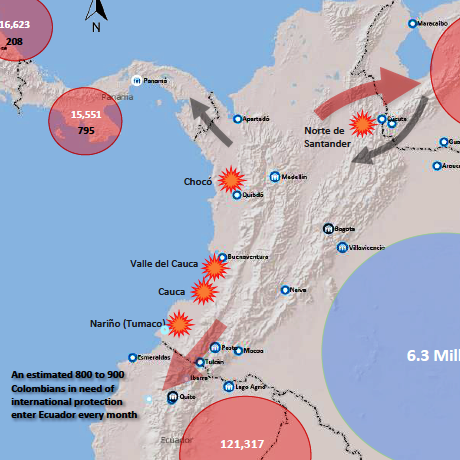
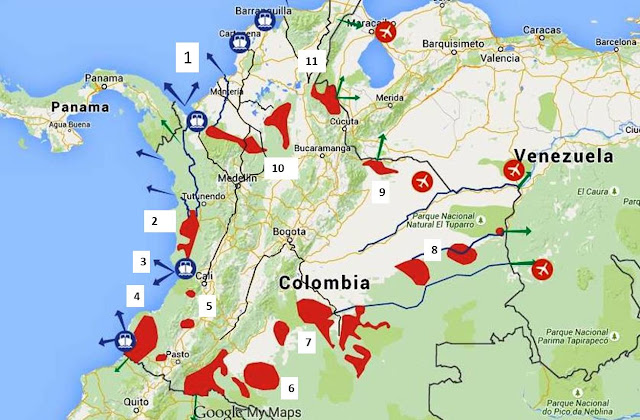
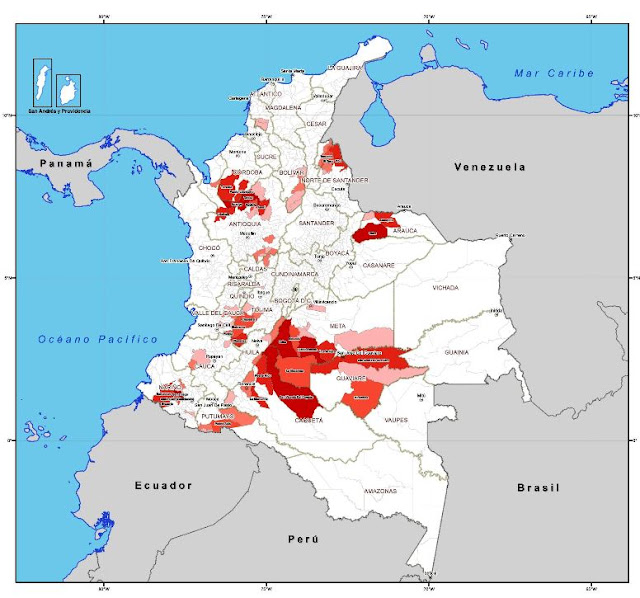
11:08
Interesting article. I live in Puerto Colombia, outside of Barranquilla. I’ve been in Puerto for a little over a year, and lived in B’quilla for about 5 years before moving to Puerto. In my 6+ years in Colombia I’ve never had any negative experiences of any kind. I’ve walked through almost every barrio of B’quilla and Puerto, at all hours of the day and night, and never a negative experience of any kind. The Caribe coast region is very safe. Back when I lived in the States, in Tucson, AZ, I heard gun shots several times a year at a convenience store two blocks away as it was being robbed. There were neighborhoods I wouldn’t walk through after dark. Same with the Seattle area when I lived there for 30-some years.
It doesn’t matter where you live in the world, there is crime, there are problems, there are bad people; therefore, there will be bad things happening. You can’t get away from it. So what do you do? You learn about your area and you make good choices.
I love Colombia and my life here and have no plans to ever live in the US again.
13:30
thanks Chip, glad to hear you are having a good time in Pto Colombia. I lived several years on the coast and always felt welcome there!